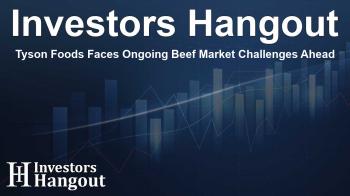Tyson Foods Faces Ongoing Beef Market Challenges Ahead

Tyson Foods and the Beef Market's Complex Landscape
Tyson Foods, Inc. (NYSE: TSN) is currently navigating a complicated market environment characterized by tight beef supplies and persistent inflationary pressures. This scenario is putting pressure on the company’s profit margins, even though its chicken segment is showing resilience and provides a vital counterbalance to these challenges.
Market Dynamics and Tyson's Balancing Act
The company's ability to balance immediate operational challenges with a long-term growth strategy is critical. An analysis from industry experts indicates significant stress factors, including supply constraints and heightened costs, presenting ongoing hurdles for Tyson Foods.
Analysts' Perspective on Future Growth
Despite the challenges, analysts, including Michael S. Lavery, retain a Neutral rating on Tyson with a projected price forecast of $58. While there is cautious optimism regarding the long-term outlook—anticipating beef supply stabilization in the next two to three years—current operational headwinds loom large, impacting the fiscal predictions for 2026.
Recovery of Cattle Herds and Supply Challenges
A noteworthy complication facing the company is the sluggish recovery in heifer retention rates, which are vital for rebuilding cattle herds. Due to these retention issues, supply shortages remain a concern, as noted by Piper Sandler.
Financial Outlook and Margin Pressure
Tyson has pointed out that fiscal 2026 might represent the lowest point in their beef supply experience. Coupled with ongoing pressures in the beef margin, supported by the HedgersEdge beef packer index, this situation is likely to remain a concern through the last quarter of fiscal 2025.
Cost Inflation Impacting Prepared Foods
Additionally, Tyson's Prepared Foods division is experiencing significant cost inflation, particularly from surging pork belly prices. Year-to-date figures reflect a staggering 41.9% increase in these prices during the third quarter, which is surpassing their pricing adjustments and starts to strain profit margins.
Operational Risks and Product Recalls
Recent operational risks have been highlighted by a substantial recall involving 58 million pounds of products, which included popular brands like State Fair and Jimmy Dean. However, analysts predict that the financial impact of this recall will likely be accounted for in future financial results.
Chicken Segment's Growth and Operational Efficiencies
In the face of these setbacks, Tyson's chicken division emerges as a beacon of growth. New forecasts project a 2.5% increase in chicken sales for the fourth quarter of fiscal 2025. This growth is attributed to enhanced operational efficiencies and a strategic shift towards value-added products.
Cost Savings and Future Projections
The chicken segment is positioned to enjoy cost savings as the company phases out its owned cold storage facilities—a strategic decision expected to yield $200 million in benefits by 2028. This operational enhancement is likely to elevate chicken profit margins from their current 8% towards historical averages of around 10-11%.
Financial Stability Amid Challenges
Financially, analysts maintain their projections for fiscal 2025 earnings per share (EPS) at $3.90, with a conservative estimate of $4.20 for fiscal 2026, supporting the notion of stable profitability. Revenue expectations indicate modest growth, anticipated to rise from $54.7 billion in fiscal 2025 to $55.5 billion in fiscal 2026.
Risks and Consumer Demand
It's crucial to note that ongoing supply constraints remain the primary risk factor for these forecasts, in addition to widespread concerns regarding livestock pricing volatility and a gradual weakening of consumer demand.
Summary of Future Prospects
In summary, Tyson Foods appears to be managing substantial yet manageable obstacles as it strives for growth. The positive performance of its chicken segment combats the margin pressures stemming from beef supply and cost inflation in prepared foods.
The company’s future direction will rely on effectively rebuilding cattle herds and maintaining cost management initiatives, with Tyson poised to achieve steady profitability while strategically preparing for eventual supply stabilization.
Frequently Asked Questions
What challenges is Tyson Foods currently facing?
Tyson Foods is dealing with tight beef supplies, cost inflation, and operational challenges that are affecting profit margins.
What outlook do analysts have for Tyson Foods?
Analysts maintain a Neutral rating with a price target of $58 while highlighting potential supply stabilization in the future.
How is Tyson's chicken segment performing?
The chicken segment is showing notable growth, with fourth-quarter sales expected to increase due to operational efficiencies and value-added products.
What impact has cost inflation had on Tyson Foods?
Cost inflation, particularly related to pork belly prices, is significantly impacting Tyson's Prepared Foods division, straining margins.
What is the future financial outlook for Tyson Foods?
Tyson expects modest revenue growth, with EPS estimates indicating stable core profitability for fiscal years 2025 and 2026.
About The Author
Contact Logan Wright privately here. Or send an email with ATTN: Logan Wright as the subject to contact@investorshangout.com.
About Investors Hangout
Investors Hangout is a leading online stock forum for financial discussion and learning, offering a wide range of free tools and resources. It draws in traders of all levels, who exchange market knowledge, investigate trading tactics, and keep an eye on industry developments in real time. Featuring financial articles, stock message boards, quotes, charts, company profiles, and live news updates. Through cooperative learning and a wealth of informational resources, it helps users from novices creating their first portfolios to experts honing their techniques. Join Investors Hangout today: https://investorshangout.com/
The content of this article is based on factual, publicly available information and does not represent legal, financial, or investment advice. Investors Hangout does not offer financial advice, and the author is not a licensed financial advisor. Consult a qualified advisor before making any financial or investment decisions based on this article. This article should not be considered advice to purchase, sell, or hold any securities or other investments. If any of the material provided here is inaccurate, please contact us for corrections.

